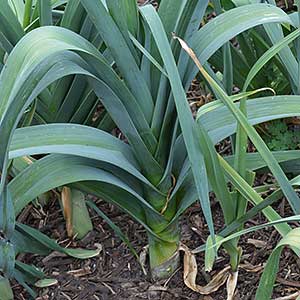
Not as widely grown in Australia as in Europe, Leeks are a slow growing vegetable that can be grown from seeds or seedlings.
The interesting thing is that they are used almost as ornamentals in cottage gardens, they are after all the national floral emblem of Wales. So you could just plant a few in the ornamental garden if you like, they do have attractive foliage.
They are easy to grow and this is why they are so popular, much easier than onions, so usually cheap, however growing your own is cheaper and you will have lovely fresh produce for the kitchen. Different parts have different flavours, the white lower stem is a sweeter milder taste than the upper leaves which are a stronger taste.
And what is the most famous Leek recipe – Leek and Potato Pie
Growing leeks from seed
Usually grown from seed and in cooler climates you can usually get two crops a year, one sown in late winter and one in late summer to autumn.
Seed can be planted directly, or you might start the seeds off indoors during winter in a moist but free draining potting mix.
Those white stems are produced by blanching, and this is done by planting in deep drills and adding soil as they grow, or ‘hilling up’ which means you mound the soil up as they grow.
Preparing the garden bed for growing Leeks
Grow leeks in a humus rich well drained soil in a sunny position. Seeds and seedlings can be planted in late winter to autumn.
- Weed and dig the area over well and add some well rotted compost and aged animal manure, a little blood and bone and a handful of lime for each square meter. A little nitrogenous fertiliser as well, leeks do like nitrogen.
- Let the bed rest for a week or two, rake over and remove any new weeds
- Ensure that the grange is good, leeks like moisture, but not wet soil.
- Prepare some long drills around 15cm deep and sow the seed directly, only cover lightly, as we are going to ‘hill up’ by filling in the trench as we go.
- If you have started the seeds of indoors you will have some shoots around 10cm long. Choose a cool spell and separate these, plant in the drills and as they grow back fill a little every 3 weeks.
- This covers the stems and keeps them nice and white.
- Water once or twice a week depending on the weather, more in dry spells. We use a liquid seaweed fertiliser, however we have also use ‘Miracle Grow’ with good results.
- Add a little fine mulch every few weeks as well, this helps with the blanching as will as keeping the moisture levels up.
Leek Varieties
- American Flag
- Autumn Giant
- Bulgarian Giant
- Elephant
- Carentan – Popular old European variety.
- Musselburg – Famous variety from Scotland
Harvest
- As you have prepared a good deep soil, harvesting is easy, simply pull them out as you need them.
- One trick is to part pull the leek out until you can see the roots, slice the upper part off at root level and push the roots back in. With a little luck you will get another leek, smaller, but just as tasty.
Talking Points
- Leeks can take between 5 months and 7 months to grow to maturity and the actual time will depend on the variety and the climate.
- The early season varieties are the fastest to grow, however they are a little less hardy than others.
- All leeks need a sunny position and a soil with lots of good organic matter mixed through.
- Early types can be be grown from seed sown indoors in mid to late winter.
- It is best to sow them into trays, let them grow until they around 6 inches tall and then transplant them into the garden in rows around 12 inches apart.
- Once planted, water in well and keep the soil around them weed free using a garden hoe.
- Harvest when they reach a good size.
- Leeks are a versatile plant in the kitchen with Leek and Potato soup being a favourite and well a stir fries tarts and pies.
Problems
- Leeks are tough.
Usually because of lack of, or inconsistent moisture, or you have not blanched the stem by ‘hilling up’
